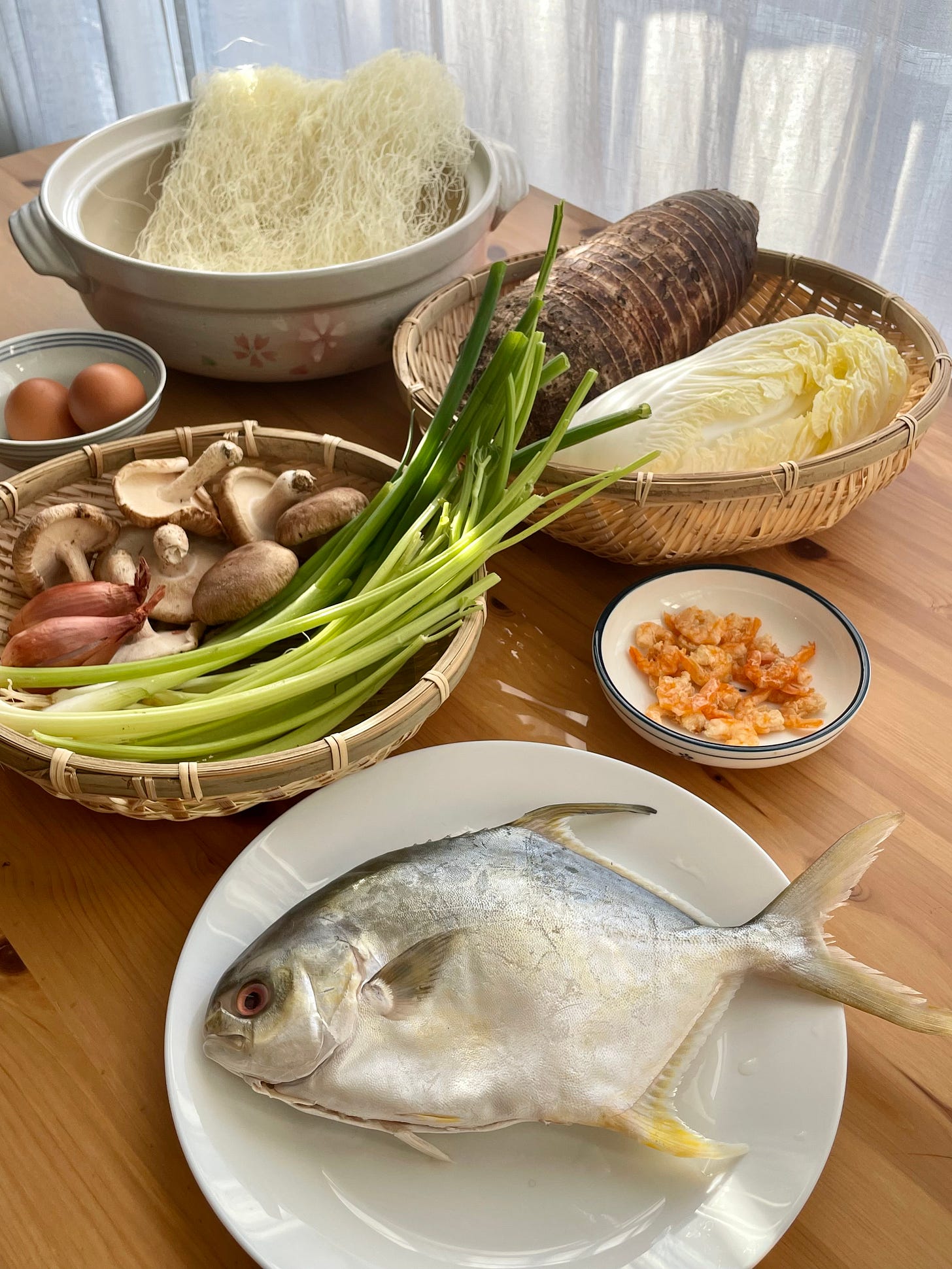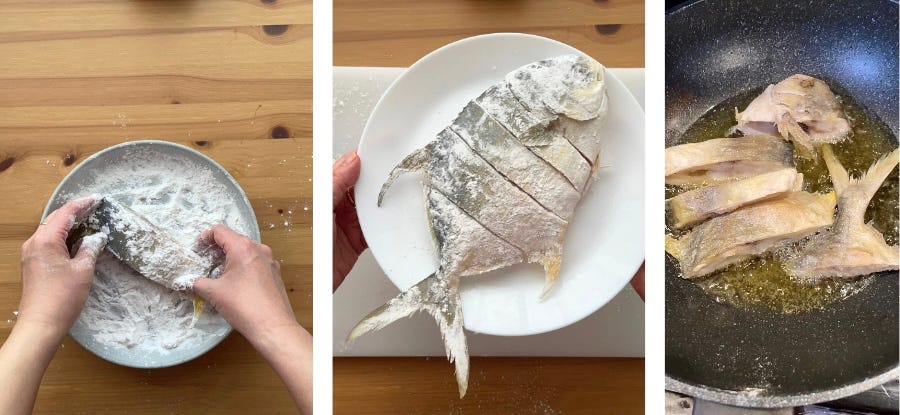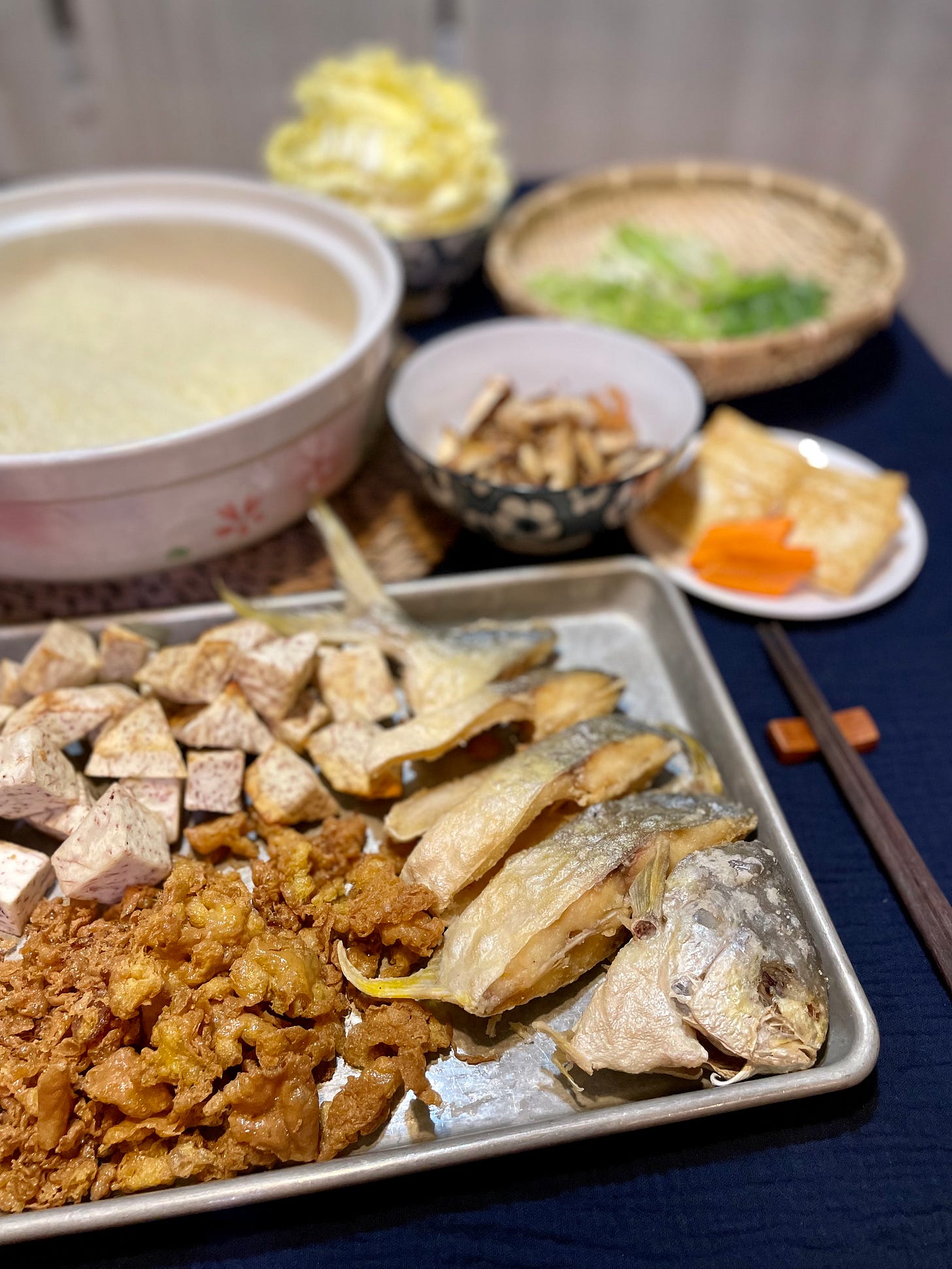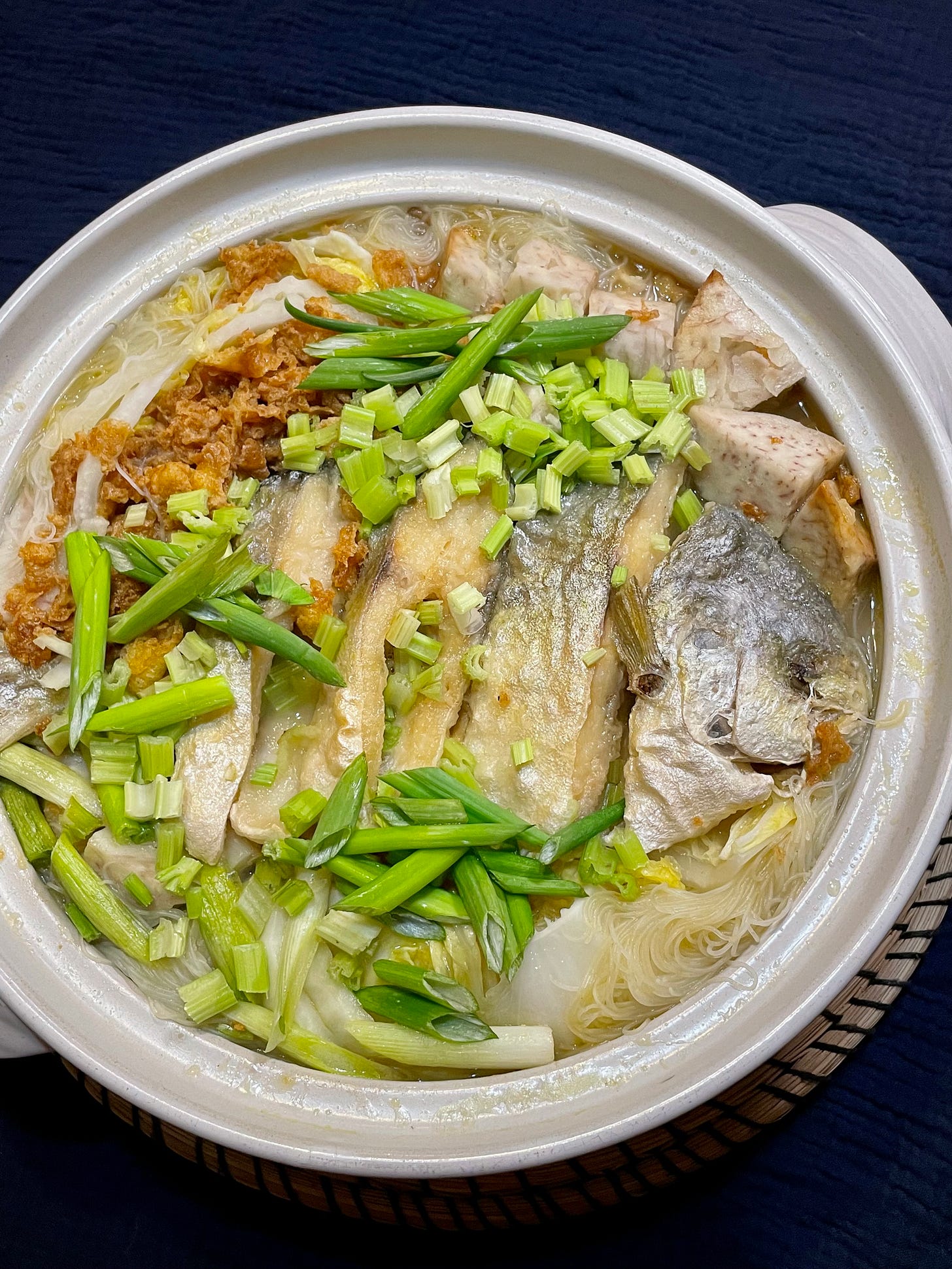Butterfish and Bihun Clay Pot (鯧魚米粉)
Elegant enough for New Year's Eve, casual enough for a Sunday dinner, Taiwanese through and through
Butterfish and Bihun Clay Pot (chang yu mi fun, 鯧魚米粉) is a cherished Taiwanese dish, often gracing New Year's Eve tables and the menus of Taiwanese cuisine specialists across Taiwan. Its meticulous preparation and the symbolism behind butterfish make serving it a gesture of genuine hospitality and abundant generosity in Taiwanese culture.
I recently stumbled upon a frozen ready-to-eat version of this dish by Taiwanese brand Lao-Hsieh-Jen (老協珍) at my local Costco. I was absolutely thrilled to find such a genuine Taiwanese delicacy available right here in my vicinity, a typical part of the American Northeast with no substantial Taiwanese presence. While I heard rave reviews about it from Taiwanese folks online, I opted to embark on the challenge of crafting it from scratch and take a trip down memory lane.
Although limited these days due to her health, my grandmother is a talented, self-taught cook, often whipping up fancy dishes such as deep-fried sweet and sour fish and da lu mien for guests gathered around a round table for graduations, birthdays, and of course New Years. In her more energetic days, my grandmother would often prepare variations of fish clay pots. Making this dish myself is my way of creating another shared experience with her.
Despite its impressive presentation, preparing this dish is actually quite simple; all it takes is being willing to do a bit of deep frying. I've introduced some napa cabbage to my rendition, a slight departure from tradition but a welcomed addition to this hearty soup.
Butterfish Bihun happens to be the signature dish of the one Michelin-star Taiwanese restaurant Fujin Tree (fu jin shu, 富錦樹) in Taipei, a culinary gem I eagerly anticipate visiting.
Let's delve into the making of this dish:
The essence of this dish lies in its gentle yet intricate layers of flavors.
It begins with a rich stock crafted from stewing hen and pork bones. Shallots, dried shrimp, and shiitake mushrooms are pan-fried to give this dish the signature Taiwanese fragrance. Then comes the patient process of deep-frying various ingredients to infuse the soup with. Perhaps the most intriguing technique is the use of deep-fried egg blossoms (ja dan su, 炸蛋酥), reminiscent of more modest times in Taiwan when meat was scarce.
This method imparts a delightful toasty fragrance to the dish, a hallmark of many traditional Taiwanese delicacies such as stewed napa cabbage (beh tsai lo in Taiwanese, 白菜滷). Furthermore, deep-frying ensures the integrity of the fish and taro, preventing them from disintegrating in the soup.
The star of the show is butterfish, also known as Pompano, prized for its round shape, silvery skin, and long yellow fins. Its Chinese name, chang, shares the same pronunciation as the character 昌, meaning flourishing. Thus, it's a popular choice for New Year's celebrations, symbolizing good luck and abundance. While butterfish is readily farmed in Asian countries and easily accessible, it's worth noting that white pompanos, its rare and wild-caught counterparts, were once used, albeit sparingly due to their scarcity and expense. Belt fish also makes for a popular alternative, but any fish with firm flesh, such as a small whole dorade fish, can be substituted.
A few other pointers I’d like to share:
You won't need any specialized equipment beyond a 6-quart or larger clay pot or Dutch oven for serving, a wok for deep-frying, and a trusty slotted spoon.
You can use any type of rice noodles, but rice vermicelli noodles, or bihun are typically used. The downside to using them is their short cooking time, so be sure to serve as soon as the noodles are cooked.
While thinly diced Chinese celery adds a customary touch, regular celery can serve as a suitable substitute, albeit with a slightly milder flavor.
I reached for scallions for this recipe, although Chinese leeks are the customary herbage if you're fortunate enough to find them.
Even though making this dish from scratch is more work than the Costco route, it reminded me of the important role food serves as a bridge between past and present, a vessel for preserving traditions and creating new memories. I hope you give this dish a try on a cold weekend, or next time you have friends over.
Ingredients
MAKES ONE LARGE SIX QUART SOUP
One 1-lb Golden Pompano fish
1/4 cup all-purpose flour
2 cups oil with high smoke point such as avocado, refined coconut, or high oleic acid sunflower oil
2 cups taro, peeled and cut roughly into 1” chunks
2 eggs, scrambled with a pinch of salt
3 heads medium French shallots, thinly sliced
0.5 oz (15 g) dried shrimp
4 oz (113 g) Fresh shiitake mushrooms
4-6 Napa cabbage leaves, cut into big pieces
Mifun/Bihun, Taiwanese rice sticks, 1-2 servings
12 cups/ three 32-oz cartons of chicken or pork stock
4 stems of scallions, cut into 1” segments at a slant, whites and greens separated
10-12 ribs/ 113 g Chinese celery, stalks only, diced
2 tbsp soy sauce
Salt and white pepper to taste
DIRECTIONS
Prepare fish
Clean Pompano and pat dry. With a sharp cleaver, cut crosswise, through the spine, into 5-6 pieces. Drizzle rice wine and sprinkle salt all over each piece, let rest for 15 minutes. Pat dry with paper towel.
Deep fry fish
In a deep dutch oven or wok, add in 2 cups of oil, and preheat to 350F/180C or when you insert a wooden chopstick, bubbles form vigorously around it. Put the flour on a plate. Dredge the fish pieces in the flour, covering all surfaces. Shake off any excess for a thin coating.
When the oil reaches temperature, carefully add the fish, sliding each piece into the oil. Resist the temptation to move or flip them immediately. Each side should take about 3-4 minutes to get slightly golden and the skin becomes crispy. Once both sides are done, remove onto a plate lined with paper towels to cool.
Deep fry taro and eggs
Keep the heat on and into the same oil, add taro chunks, stirring occasionally, and fry until the edges turn brown and the surface of the taro forms a shell. Then we deep fry the eggs. Holding a big slotted spoon with round holes, slowly pour eggs through the spoon and into the oil, while you raise the spoon high and let the eggs rain into the oil. Stirring constantly, while breaking off big chunks into small ones, fry the eggs until they turn a light chestnut color, and the kitchen smells nutty and fragrant and you recognize the same aroma in baked goods with eggs.
Sauté shallots, mushrooms, shrimp
Filter the oil through a fine sieve to remove impurities. Make sure the deep frying vessel is clean as well; wiping with a paper towel is sufficient. Turn the heat back to medium, add in 2 tbsps oil, dried shrimp, shallots, and sautéed until fragrant and the shallots are slightly caramelized. Add in mushroom and sauté for another 3 minutes for the flavors of the shrimp, shallots and mushrooms to meld beautifully together.
Assemble clay pot
First warm up the stock in a saucepan. Keep it at a gentle boil, and add in 1 tbsp soy sauce, 1 tsp salt. Assemble everything in a big claypot, or any 6-qt pot in which you want to present this dish. Lay the rice noodles on the bottom. Lay the napa cabbage on top and around the noodles, followed by the shallots, shrimp and mushroom mixture. Lay the fried fish on top, keeping the order from head to tail. Follow that by putting the taro into the pot in two clusters. Carefully pour in the stock, just enough to reach the bottom of the fish. Add in some water if more liquid is needed. Add in the whites of the scallion, cover with a lid, and now we’re ready to bring it to cook table side.
Cook table side
Set the clay pot on a portable stove, cook until boiling with the lid on, about 5-10 minutes. Remove lid, sprinkle with white pepper, chopped celery, and scallion greens before serving immediately. Get ready for the “oo”s and “ah”s
RECIPE NOTES:
Deep frying is necessary to maintain the shape of the fish and taro chunks. You can also try air-frying them. You can’t air-fry the eggs unfortunately. I used about 2 cups of oil, though using more is beneficial in maintaining oil temperature. The less oil you use, the more difficult it is to maintain frying temperature.
Deep frying eggs tend to make the oil foamy. That’s why I recommend you do it last. Holding the slotted spoon higher creates fluffier bits of eggs. More surface area deep fried = more flavor. Plus it’s super dramatic and fun to watch. Just start low and gradually pull up to avoid oil spluttering.
Serve immediately once everything is cooked. Rice noodles cannot withstand long cooking times.
Many variations of this soup include clams. I like to nestle them around the rice noodles so they get cooked in time, especially for hard-shelled varieties such as little neck clams.








